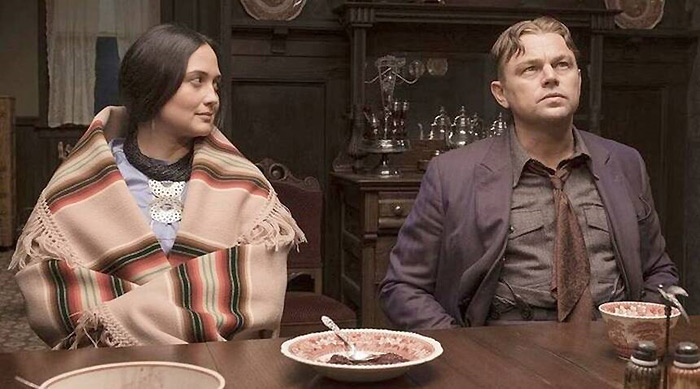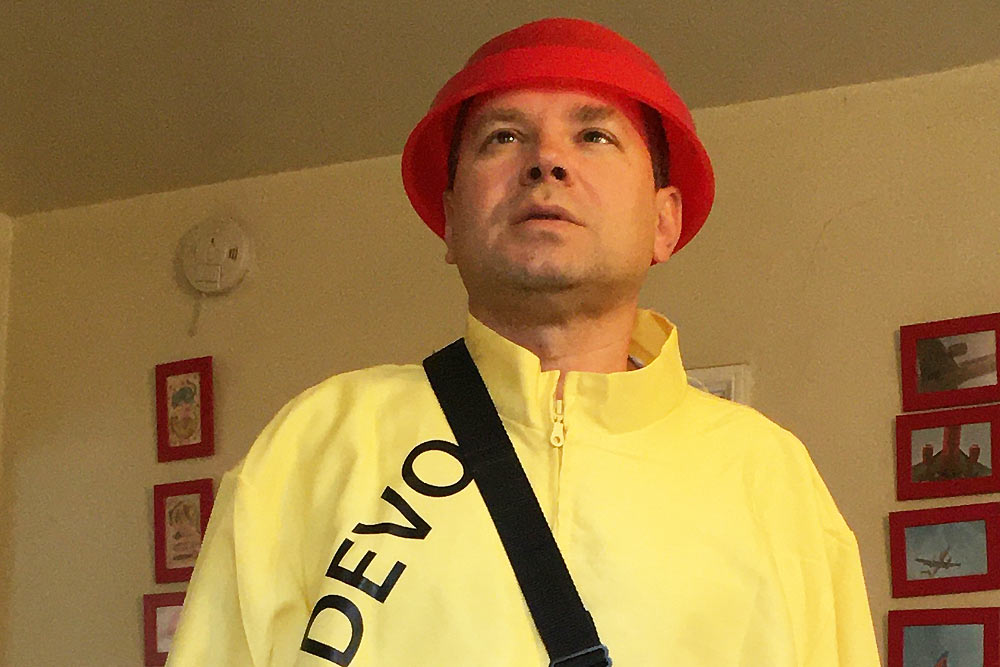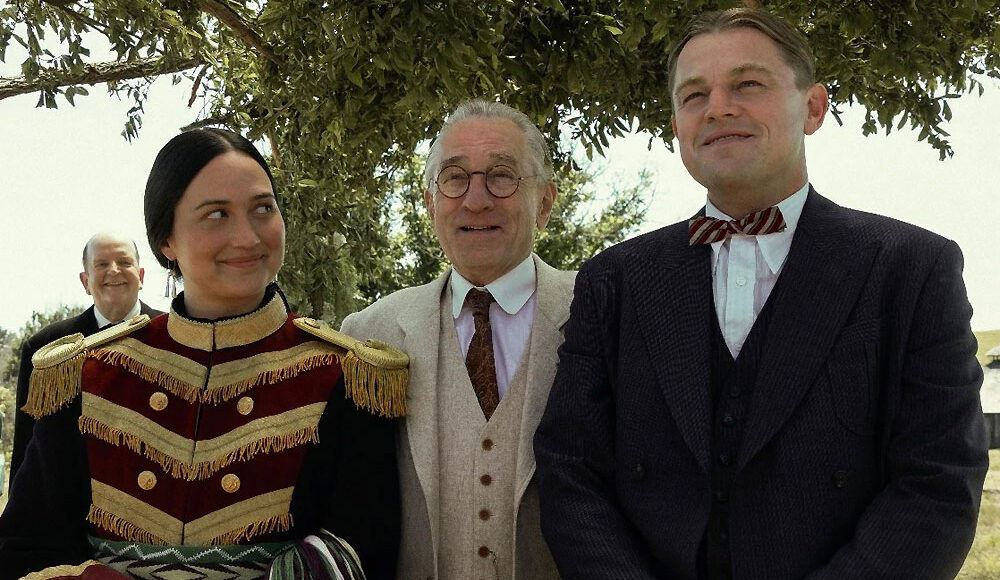By Nicu Ciumacencu — I didn’t know about the Osage Nation tragedy in the early Twentieth Century due to the discovery of oil. I didn’t know that to some humans murder can be like a glass of water, you have it when you have it, a necessity, you’ll die without it, and because it’s so simple to have it, it doesn’t matter how often or where you have it.
But I did know that Scorsese — (once he puts his mind to making a film adaptation out of a real fact, i.e. after one of Western history’s most tragic events), — will go down to every detail and will not spare any money or other resources needed. And time also. This is why the movie is three and a half hours. Which, to begin with, I wondered how come Hollywood, the studios and the producers were fine with that length. The story could have, definitely, been told in less time, —one hour less or even more— but who am I to say? If Mister Scorsese thought about over three hours of development, he must be right.
And once again he chooses De Niro and DiCaprio as his winning duo, which they don’t disappoint. In fact, they leave a lasting impression, one of their best performances ever: a team of actors that work so magnificently together, like two oil well workers busy round the clock for eight hours or so with no mistakes because one tiny miscalculation could blow them up in the sky, and no one wants that.
The book upon which the movie is based is David Grann’s novel of the same title. Essentially we’re back in the early Twentieth Century when, due to the discovery of oil on Osage Nation territories, the Native American nation became rich overnight. Not just rich but, in a matter of a couple of years, turns out to be one of the richest groups of people in America. In 1923 alone the Osage cashed in over $30 million in royalties. This wealth would also be the reason for their troubles, slowly, growing bigger and bigger.
Basically, the Osage had valuable land that other people wanted badly, people who never saw the native Americans worthy of living, and with this mentality murdering the Osage people would be easy, a piece of cake, no remorse or fear of God, as if “you’re not killing people” seemed to be in their murdererous minds.
[SPOILER ALERT FROM HERE]

The Osage were unable to fight the level of crime, hate, discrimination and murder under the total control of William King Hale (De Niro) with the assistance of his nephew Ernest Burkhardt (DiCaprio).
The scheme was simple, try to marry some women of Osage blood to slowly inherit her land and wealth then dispose of her by means of poisoning, shooting, etcetera, whatever necessary, since the local police wouldn’t do much investigation. And the number of suspicious deaths grew and grew, with no suspects or leads to whoever might be behind it. Behind it was exactly who the Osage trusted the most: William KING Hale, the local Boss.
Through cattle and other ventures, Hale became rich and powerful controlling the de facto Fairfax County politics. In Ernest, his nephew, he sees someone easy to control and influence. And to Ernest, a not very bright man, this “mentorship” is milk and honey. He needed guidance to adapt to life when returning to Oklahoma from the war in Europe.
Urged by his uncle, Ernest begins courting Mollie, a rich Osage woman majestically played by Lily Gladstone. They end up marrying just as Mollie’s family and other members of the Osage population are murdered one by one; murders arranged by Hale to collect their insurance policies and headrights for the oil rich lands.
From this moment onward, the story gravitates around the trio Hale, Ernest, Mollie, with the two men plotting against Mollie and trying to slowly kill her in various ways, one of which is injecting poison along with a new revolutionary treatment for Diabetes for that time, the insulin, which Mollie needed. Mollie survives the poisoning and the slow battle of recovery has the same pace as the slow uncovering of the murders diminishing the Osage people.
Once more as a viewer, I was stunned to see how much MURDER played out in the foundation of this country, in the making of America. To Scorsese, —the most seasoned Hollywood director in the art of wise guy dealings, street boss crimes, or the fine grafts and dirty laundry of Wolf of Wall Street— to bring to screen the shady, underground murder practices of a small but dedicated group of people in an Oklahoma county, was a challenge he wasn’t gonna miss. And bravo: The cinematography, overall artistic production and wardrobe design of Killers of The Flower Moon is impressive.
Scorsese shares screenplay credit with Eric Roth, while Rodrigo Prieto’s cinematography is masterful whether capturing the natural setting of the vast Osage territories or the bustling, fast-emerging cities built on oil business, hard work, greed, bribery, and assassination.
Lily Gladstone, whom I had not seen prior, is the perfect choice for Mollie. Her face and story are told without many words but with a body language, whisper, and a silence typical for a native American woman which is lasting.
The subtle references to the Tulsa Massacre are not fortuitous, but are part of the bigger message that the movie is projecting —the past was horrible, the people must change, their frames of minds must be redrawn, their place in nature, in Universe understood differently, accepted with humanity in the lead— and that was not possible a hundred or so years ago.
As things begin to crumble for Hale and Ernest, we even see cracks in their relationship. Hale is trying to make Ernest sign a paper renouncing his rights to his properties turning them over to his uncle in case the FBI succeeds in locking him up. It’s clear that Hale begins to see an enemy in his nephew and the unfolding action led me to think that Hale might eventually kill Ernest.
Ernest turns against his uncle in the end with both getting convicted. Peace and justice – the smallest amount achievable – begin to arrive at the doors of the Osage Nation.
There is reluctance amongst those who suffered to continue trusting the local authorities, the government, but in the end, there’s nothing they can do, and life moves on.
Oil has always killed people. Because oil is wealth, and wealth generally loves blood, it feeds on it. To Osage Nation oil was just another reason in their long-suffering as native Americans. Perhaps the movie provides a small sense of belonging, an attempt at restoring justice, pride and much more to anyone identifying as Osage or just Native American. It should provide an education to everyone else.
***
Killers of the Flower Moon is currently in theaters everywhere
Review by Nicusor Ciumacencu






